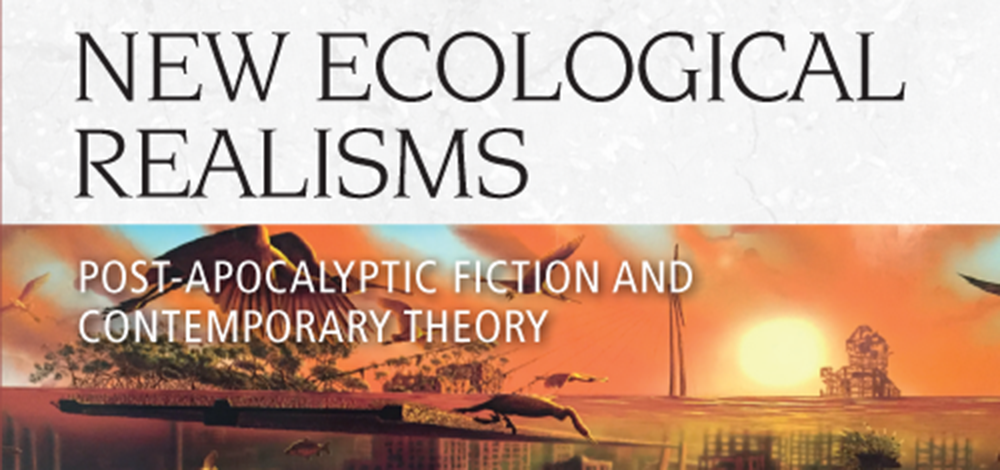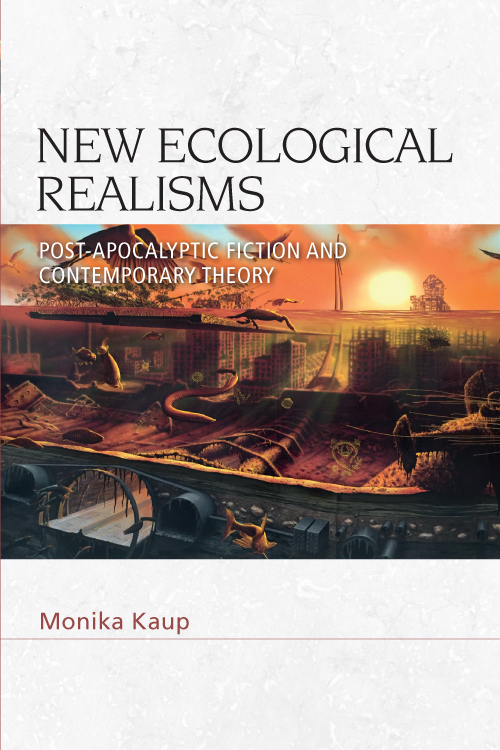
Graham Harman and Monika Kaup
Missed Part 1? Check it out here!
Or read the full conversation here.
Graham Harman: Much of the contemporary discussion of the material turn focuses on a group sometimes called the New Materialist Feminists, some of whose appeal is no doubt linked to the fact that it is an innovative philosophical school led by female thinkers. You seem quite familiar with the work of at least two of them, Karen Barad and Jane Bennett. Yet they are not among the six philosophers featured in your book, all of which are men (though you do give ample space to Margaret Atwood and Octavia Butler on the fiction side). Are you less interested in the theories of Barad and Bennett than the others, or was it simply harder to pair them up with specific fiction writers in your schema?
Monika Kaup: I am writing as a humanist of a particular type, a scholar of literature whose interest in philosophy in general and in the revival of realism after postmodernism is motivated by the larger concern of defending the unique kind of knowledge produced by the humanities in general and literary studies in particular. What defines the singularity of humanistic objects of study? What makes humanistic objects irreducible to other types of objects, such as scientific objects? My investment in philosophical realism derives from this larger interest. In the revival of realism after postmodernism, it is vital to establish that not everything that exists is in nature, as Markus Gabriel puts it. One need not be a materialist to be a realist. On this point, my position is in agreement with OOO, which similarly posits the reality of non-material objects such as art (as you show in your chapter on aesthetics in Object-Oriented Ontology: A New Theory of Everything). Humanistic objects of study are not—or at least nor primarily—material objects, like the objects of science, but a peculiar hybrid type of object that could be described as objectified subjectivity.
Although I have learned much from new materialisms (an important subgroup within the larger new ontological movement to which both Jane Bennett and Karen Barad belong) I endorse new realism rather than new materialisms. Unlike materialism, realism is not committed to the exclusion of mind-dependent objects, such as the imaginary characters and worlds of post-apocalyptic fiction. In response to your questions about gender, I would counter with another question: in addition to feminist materialisms, why are there no feminist realisms? These are the kind of female realist thinkers I would certainly have counted among the central philosophers featured in my book.
As I argue, post-apocalyptic fiction shows that something can be imaginary and still lay claim to a higher kind of realism. Thus, the imaginary scenarios of near-future post-apocalyptic fiction extrapolate the disastrous consequences seeded by present developments. Because the probable consequences (for example, rising sea levels) of present causes (such as CO2 and methane levels in the atmosphere) won’t actualize for decades to come, a narrowly defined materialist realism will miss the mark. Situations like climate change, whose full reality is as-yet-unknown and slow to manifest, call for alternative varieties of realism that include imagination, in the form of risk-based speculation, as an essential element. Post-apocalyptic fiction thus resorts to speculative realism for similar reasons as does its philosophical sibling SR (with which it should not be confused, however): tackling a problem inaccessible with the methods of conventional realism.
Post-apocalyptic fiction shows that something can be imaginary and still lay claim to a higher kind of realism.
Graham Harman: Let’s move now through the philosophers covered in your book, though of course you are free to bring up their fiction-writing partners in your responses as well. (Since the Speculative Realism series is a philosophy series, my questions are simply emphasizing the philosophy side of your work.) The first is Bruno Latour, who obviously has a wide following in multiple fields, though his influence in philosophy itself is still relatively minimal. What is most important to you about Latour’s work?
Monika Kaup: Latour’s philosophy is, as you yourself have observed, a realism of relations. For Latour, what makes things real is not their autonomy or their pre-given existence, but their embedding as actants in larger organized wholes, webs of interaction that he calls actor-networks. Latour comes first in my book for several reasons. For one, his actor-network theory enacts the paradigmatic shift that Fritjof Capra, in his account of the rise of systems thinking—a term that designates one variety of contextual realism represented by Maturana and Varela, but which I also use as to characterize the overall paradigm—has succinctly described as a figure/ground shift from objects to relationships. In the mechanistic view, isolated objects are primary and the relationships in which they are embedded, secondary. In the systems view, organized wholes are primary, and the objects they embed, secondary. These two views are complementary rather than mutually exclusive; their value is relative to specific situations (fields in Gabriel’s parlance) and kinds of existents.
Further, as the name of Latour’s variety of organized wholes—actor-networks—suggests, relationships are no less real than the objects they connect. In Latour’s model, it is the interactions between individual objects (actants) that generate the whole (the network). Latour’s model of contextual realism is thus premised on immanence and emergence. The actor-network is created by its multiple participants rather than preexisting them, or if it does, it is continuously transformed by their activity. For example, if you introduce an alien species into an ecosystem that is not its native habitat, this species will change the overall dynamics of its food web. If, as was the case with Asian carp introduced into the Mississippi River decades ago, the new species encounters few or no natural predators, it will become an invasive species that will radically transform or even destroy the ecosystem. Asian carp are such powerful actants that governments of states bordering the Great Lakes are paying billions of dollars to keep them out of the Great Lakes marine ecosystem. The same transformations have occurred naturally over billions of years in the evolution of life. It might be argued that the case is different in the human social realm. Organisms are alive, but social and mental objects are not. And isn’t it absurd to deny that the genre of the novel preexists the publication of specific works in multiple ways—as a canon of masterpieces, for example, or at least as an expectation in the minds of readers? Of course it is. Yet far from being static, this literary system undergoes constant transformation resulting from new publications (the novel genre was not the same after the 1922 publication of Ulysses or, later, Gabriel García Márquez’s One Hundred Years of Solitude).
This in turn illuminates another key premise of Latour’s theory—the principle of irreduction. Irreduction establishes that in any complex whole, especially social ensembles, there are no privileged forces (such as genes or capitalism, and so on) that function as hidden causes generating a multitude of manifest effects (such as organisms, art or religion). Actor-networks have flat ontologies. Nothing is reducible to anything else. As the term actant suggests, agency is distributed rather than following linear cause-effect pathways; it flows in all directions. Actants are neither subjects nor objects, neither active nor passive, but both—acted upon and effecting something else in their turn.
The principle of irreduction is another reason Latour comes first in my book, for it breaks the hierarchy of objects (some taken to be “real,” others “constructed” by objects accepted as real) underpinning the modern tradition of critique, to which the linguistic turn and postmodern constructivism belong. Like Gabriel (adapting Schelling’s example), Latour can be thought of as formulating both a negative and a positive ontology.
Latour’s negative ontology is the irreductionist critique of modernity in general, and of the modern epistemology of critique in particular. One specific instance I have found particularly helpful is the concept of the “factish,” a neologism Latour coins to dismantle the hierarchy of facts (things assumed to be real) and fabrications (things assumed to be constructed and debunked as fictitious). The term factish designates the same principle as does the concept of actants, the idea that things can both be human artifacts as well as having transformative effects on other things. In her MaddAddam trilogy, Atwood shows that this is the case for artificial species bioengineered by humans. Having escaped their cages and gone feral in the post-apocalyptic world after the annihilation of most humans, the artifacts of human bioengineering develop autonomous agency that wasn’t intended by their geneticist creators. Organisms are not determined by their genes. Genes are not the overmastering reality of life that the developing organism reproduces passively.
To move on to Latour’s positive ontology: the positive counterpart of irreduction is the imperative Latour calls composition. Composition is about making rather than unmaking, going beyond the critique of critique to recompose the world in according to nonmodern organizational principles. The third volume of the MaddAddam trilogy offers a particularly good illustration of what this means. MaddAddam moves beyond the retrospective account of the events leading up to the apocalypse central to the first two volumes, Oryx and Crake and The Year of the Flood, and turns towards the future, tracing the beginnings of a genuinely post-apocalyptic history. In Maddaddam, the handful of surviving humans join forces with two artificial species, the humanoid Crakers and the transgenic pigoons, to form a multi-species ecological collective. Unlike societies, which are collectives of a single species, ecologies are collectives of multiple species. The events of MaddAddam evoke Latour’s well-known call of arms, “after nature, it is society that has to go.” In Atwood’s trilogy, nature as such is dead because nature has been fundamentally altered by humans, and so is human “society” (too few humans survive the bioterrorist annihilation of humans immediately preceding the narrated events). In Latour’s parlance, humans, Crakers and pigoons become actants in a new post-apocalyptic actor-network that is formed on the ruins of the defunct modern civilization. Maddaddam traces the beginnings of a spontaneous multi-species evolution of humans and non-humans.
Apocalyptic narrative comes in two varieties, apocalyptic narrative proper and post-apocalyptic narrative. While apocalyptic narratives are fictions of world-destruction, post-apocalyptic narratives are fictions of world-remaking after the end. Narratives of survival, post-apocalyptic fiction is about crawling out of the ruins and reassembling the world on the post-collapse wasteland on which they have been shipwrecked. Latour’s compositionism captures the oddly hopeful tone of post-apocalyptic fiction, which contrasts with the doom characteristic of apocalyptic narrative proper. Like post-apocalypse, compositionism is about starting from scratch, and like Latour, Atwood follows the actants and traces the network—an ecological collection of humans and trans-genic non-humans.
Stay tuned
“A Conversation with Graham Harman and Monika Kaup on ‘New Ecological Realisms’” Part 3 and 4 coming soon!
Want to keep up to date on our latest Philosophy books? Sign up to our mailing list.
About the book
Presents post-apocalyptic fiction as a unique source of new realist ontologies
- Shows how new realism reshapes humanistic inquiry in the age of climate change
- Contributes to the rehabilitation and reframing of realism after postmodernism
- Introduces a new contextual and ecological realism that reconnects the human cultural world with non-humans and the environment
About the author
Monika Kaup is Professor of English at the University of Washington. She is the author of Neobaroque in the Americas: Alternative Modernities in Literature, Visual Art, and Film (University of Virginia Press 2012) and she is co-editor of Baroque New Worlds: Representation, Transculturation, Counterconquest (Duke University Press 2010).






